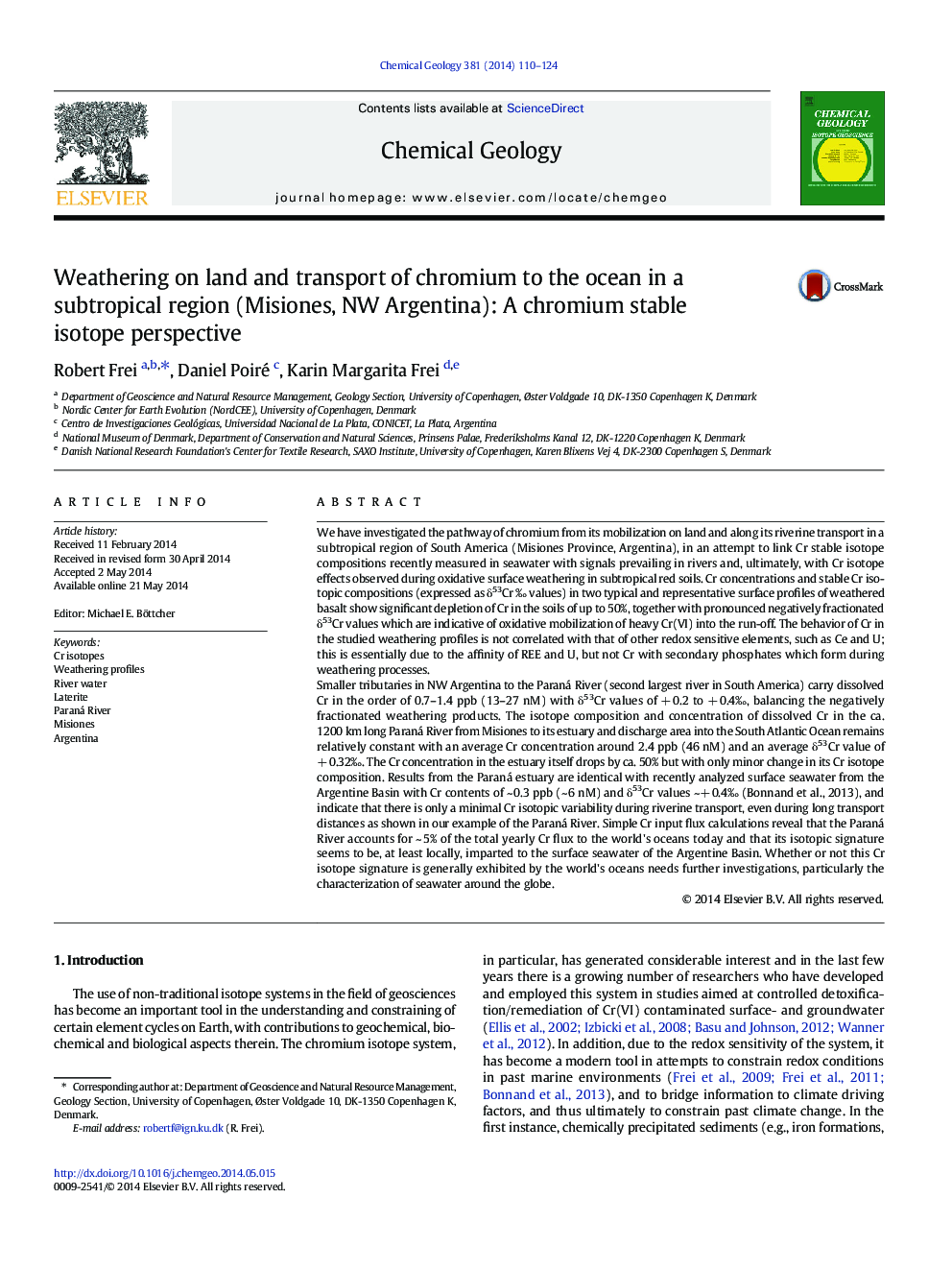| کد مقاله | کد نشریه | سال انتشار | مقاله انگلیسی | نسخه تمام متن |
|---|---|---|---|---|
| 6436603 | 1637591 | 2014 | 15 صفحه PDF | دانلود رایگان |

- Cr isotopes behave conservatively during ~Â 1200Â km transport in the Paraná River in subtropical Argentina.
- Total dissolved riverine Cr is isotopically heavy (δ53Cr ~+ 0.35â°) and indistinguishable from Cr in the South Atlantic Ocean.
- Cr is up to 50% depleted in lateritic weathering profiles and is enriched in the light isotopes.
- Adsorptive processes onto particulate load cause chromium in smaller tributaries to be lower than that in the Paraná River.
- Re-distribution of redox sensitive chromium in weathering profiles is not correlated with that of Ce and U.
We have investigated the pathway of chromium from its mobilization on land and along its riverine transport in a subtropical region of South America (Misiones Province, Argentina), in an attempt to link Cr stable isotope compositions recently measured in seawater with signals prevailing in rivers and, ultimately, with Cr isotope effects observed during oxidative surface weathering in subtropical red soils. Cr concentrations and stable Cr isotopic compositions (expressed as δ53Cr â° values) in two typical and representative surface profiles of weathered basalt show significant depletion of Cr in the soils of up to 50%, together with pronounced negatively fractionated δ53Cr values which are indicative of oxidative mobilization of heavy Cr(VI) into the run-off. The behavior of Cr in the studied weathering profiles is not correlated with that of other redox sensitive elements, such as Ce and U; this is essentially due to the affinity of REE and U, but not Cr with secondary phosphates which form during weathering processes.Smaller tributaries in NW Argentina to the Paraná River (second largest river in South America) carry dissolved Cr in the order of 0.7-1.4 ppb (13-27 nM) with δ53Cr values of + 0.2 to + 0.4â°, balancing the negatively fractionated weathering products. The isotope composition and concentration of dissolved Cr in the ca. 1200 km long Paraná River from Misiones to its estuary and discharge area into the South Atlantic Ocean remains relatively constant with an average Cr concentration around 2.4 ppb (46 nM) and an average δ53Cr value of + 0.32â°. The Cr concentration in the estuary itself drops by ca. 50% but with only minor change in its Cr isotope composition. Results from the Paraná estuary are identical with recently analyzed surface seawater from the Argentine Basin with Cr contents of ~ 0.3 ppb (~ 6 nM) and δ53Cr values ~+ 0.4â° (Bonnand et al., 2013), and indicate that there is only a minimal Cr isotopic variability during riverine transport, even during long transport distances as shown in our example of the Paraná River. Simple Cr input flux calculations reveal that the Paraná River accounts for ~ 5% of the total yearly Cr flux to the world's oceans today and that its isotopic signature seems to be, at least locally, imparted to the surface seawater of the Argentine Basin. Whether or not this Cr isotope signature is generally exhibited by the world's oceans needs further investigations, particularly the characterization of seawater around the globe.
Journal: Chemical Geology - Volume 381, 14 August 2014, Pages 110-124